In a botanical sense, an herb is a plant that does not produce a woody stem and dies back to the ground each winter to a perennial root system. In a gardening sense, herbs are plants that serve as a major source of seasonings in food preparation. In an even broader sense, herbs include plants that are also useful for scents in cosmetics or for medicinal purposes. Some of them are woody and outstep the definition of an herbaceous plant.
For American pioneers, herbs were the major source of seasonings for foods. They were also used for curing illnesses, storing with linens, strewing on floors, covering the bad taste of meats before refrigeration was devised, dyeing homespun fabrics, and as fragrances.
With the advent of the supermarket, growing herbs in the garden declined because a wide range of dried herbs became available in stores. Now, however, with an increase in the popularity of ethnic foods, combined with a realization that fresh herbs have more distinctive tastes than some dried herbs, more gardeners are growing at least a few herbs for fresh use, drying or freezing. Increasing interest in herbal medicine has also helped make herb growing more popular. In addition, some herbs are ornamental and make attractive plants for a garden (Figure 1).
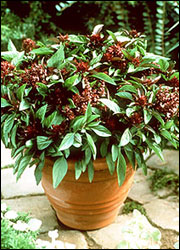 Figure 1
Figure 1
Thai basil can be used both as a culinary herb and as an ornamental.
General culture
Sunlight
Most herbs are easy to grow, but you must select the proper location to grow them. A sunny location is required by most herbs, and only a few, including angelica, woodruff and sweet cicely, are better grown in partial shade. The oils, which account for the herbs' flavor, are produced in the greatest quantity when plants receive six to eight hours of full sunlight each day. If you don't have a good, sunny location, many herbs will tolerate light shade, but their growth and quality will not be as good.
Soil
Herbs will grow in any good garden soil. The soil should not be extremely acid or alkaline; a soil nearly neutral is best for most herbs. A pH between 6.5 and 7.0 produces the best herbs.
Herbs grow best when soils have adequate organic matter. Most herbs do not require highly fertile soil. Highly fertile soils tend to produce excessive foliage that is poor in flavor.
In preparing average soils, incorporate 4 inches of peat moss or compost into the garden area to improve soil condition and help retain moisture.
Drainage
When selecting a site for an herb garden, you must consider drainage. None of the important herbs grow in wet soils, but a few, such as mint, angelica and lovage, thrive in fairly moist soils.
If the only area available is poorly drained, you need to modify the area. Build raised beds or install underground drainage tiles to grow herbs successfully.
Preparation
Once you select a site, cultivate the soil to a depth of 12 to 18 inches, then level it. If only a shallow layer of topsoil exists above hard subsoil, remove the topsoil temporarily. Break up the subsoil, adding organic matter. After improving the subsoil, put it back. Even though the topsoil may be better than the subsoil, the topsoil may also need additional organic matter.
Pests
Few insects or diseases attack herbs. In some localities, rusts infect mints. In hot, dry weather, spider mites damage some herbs.
Aphids attack anise, caraway, dill and fennel. Grasshoppers and certain caterpillars attack herbs when conditions are right. Control is usually not necessary until you notice a problem. If control is warranted and pesticides are used, make certain they are labeled for food crops if the herbs are to be used for culinary purposes.
Propagation from seeds
You can grow many herbs from seeds. If possible, sow the seeds in pots or flats indoors in late winter. They need a sunny window and cool temperatures (60 degrees F) for best growth. Treat young plants for the garden just as you would treat young salvia or pepper plants.
Because some plants take longer than others to develop, start those with smaller seeds first, preferably in February. You may later transplant them into individual pots and plant them in the garden after danger of frost is past. The finer the seeds, the shallower you should sow them.
A few herbs do not transplant well. Sow them directly into the garden. Plant anise, coriander, dill and fennel directly in the garden and don't transplant them.
For direct seeding outdoors, plant in spring after all danger of frost is past and the soil is beginning to warm up. Make the soil into a fine, level seed bed. As a general rule, sow seeds at a depth of twice their diameter.
Propagation from cutting, division and layering
Some established herbs multiply asexually by cutting, division or layering.
Layering is suitable for many perennials with flexible branches. Division works well for tarragon, chives and mint. Lavender, lemon balm, scented geraniums, sage and rosemary can be propagated from cuttings.
You can take cuttings of herbs any time during late spring and summer from healthy, well-established plants. Cuttings taken in fall take longer to root. Healthy tip growth makes the best cuttings. Cuttings of vigorous soft shoots or old woody stems are less desirable.
Cut just below a node to form a cutting that is 3 to 5 inches long. Most herbs should root in two to four weeks. After rooting, overwinter them indoors in pots in a sunny window or in a cold frame. Plant them outdoors in a permanent location the following spring.
Division is useful for multiplying healthy, established plants that may be two to four years old. Division allows modest increase for plant like chives, mints and French tarragon. Divide herbs in early spring before growth begins. Dig up the old plant and cut or pull it apart into sections. Replant the sections and keep them moist until the new plants are established.
Layering is the simplest and most reliable method to increase perennial herbs such as thyme, lemon balm, winter savory, sage, bay and rosemary. The basic principle is to produce roots on a stem while it is still attached to the parent plant. After the stem forms roots, detach the new plant from the parent. Select a healthy branch that is growing close to the ground and that is flexible enough to bend down to the soil. While holding the branch close to the soil, bend the top 6 to 10 inches of the stem into a vertical position. It may be helpful to scrape the bark on the underside of the branch at the bend. Bury the bent, scraped portion 3 to 6 inches deep, and anchor it with a wire loop. Insert a small stake to hold the top upright. Water thoroughly.
Layering can be done anytime from spring to late summer. Allow the rooted shoot to remain in place until the following spring. Then cut it from the parent plant and plant it into the desired location.
Winter protection
Many herbs suffer winter damage in our climate, so some winter protection for perennial herbs is advisable. Many herbs have shallow roots that heave out during spring thawing and freezing of soil. A loose mulch spread over the roots about 4 inches deep can provide adequate protection. Evergreen boughs, straw or oak leaves are good materials for a mulch. Don't mulch until after the ground is frozen in early winter. Do not remove mulch until you see signs of new growth in the early spring. If the mulch compacts during the winter from heavy snows, fluff it up in early spring before growth begins.
Harvesting herbs
Depending on the herb, harvest may include one or more plant parts. In most cases you harvest the leaves but in some cases the flowers, seeds or roots are harvested. Handle blossoms just as you would handle leaves. Often, you harvest blossoms with the leaves and mix them together. Dried herbs lose quality in two to three years. Discard them if you haven't used them in that time.
Leaves
To determine the best harvest time for each herb, you need some experience. However, a few general rules can lead you in the right direction for most herbs. Harvest the leaves when they contain the optimum amount of essential oils. These oils give herbs their special flavor or scent. Ideally you should cut herbs soon after the dew has evaporated from the leaves in the morning. Harvest on a dry day that has been preceded by at least two sunny days.
In most cases, cut stems for harvest when the flower buds are just beginning to open. Mints, however, have the most oil in the leaves when the spikes are in full bloom.
When gathering a large quantity of herbs, use an open-weave basket or containers that allow good air movement. Don't place herbs into plastic bags, which can heat up and cause rapid deterioration of the plant parts. Never cut more stems than you can conveniently dry at one time. You can cut back a perennial herb to about half its height and can cut down an annual to a few inches. You can also remove an annual completely near the end of the season.
Wash the plants in cool water immediately after gathering and spread them on towels. Pat them gently with a towel until dry. A dark, well-ventilated room where temperatures run between 70 and 90 degrees F is an excellent room for drying. Air conditioning is helpful, because it reduces humidity in the air. You can use frames covered with cheesecloth or other netting, or metal window screens with cheesecloth laid on top for drying. Prepare the frames or screens before you cut the plants.
For some herbs, you strip the leaves from the stems before drying. Herbs in this group include basil, dill, lemon balm, lovage, mint, sage, lemon verbena and tarragon. Spread these leaves in single layers for quickest drying.
Herbs with smaller leaves can be dried on the stems. These herbs include thyme, summer and winter savory, rosemary, oregano and marjoram. Strip the leaves after drying is complete.
Herb leaves should dry in three to four days under proper conditions. In humid weather, you may need to spread the herbs on a cookie sheet and dry them in an oven at about 125 degrees F for a few minutes before placing them in an airtight container.
Some herbs do not dry well at home. Instead, you can freeze them. Handle them as you would for drying. Then after washing, blanch them in boiling, unsalted water for 50 seconds, cool quickly in ice water and blot dry. Spread them in a single layer on paper or cookie sheets and place them in the freezer.
You can freeze dill, chives and basil without blanching. After the herbs are frozen, place them in airtight plastic containers or bags.
Roots
Angelica and lovage produce usable roots. Dig these roots in the late fall or early spring. Wash them thoroughly after digging. Then slice or split the large roots. Place the pieces in thin layers on screens and turn the slices several times a week. After they are partially dry, finish them in an oven at low heat before placing them in an airtight container for storage. It may take roots six to eight weeks to dry completely. When dry, the root piece should snap when you bend it.
Seeds
You can grow and process seeds of dill, caraway, fennel and anise at home. When the plants begin to mature and yellow, cut the heads of the plants containing the seeds, leaving a short stem. Place them on a drying tray for five or six days. Then the seeds should fall fairly easily from the heads. Remove the chaff, and allow the seeds to continue to dry for another week. Stir them frequently. Store seeds in airtight jars after complete drying.
Herbs indoors
Many herbs can be grown indoors, but they will be less productive than those grown outdoors. They are best used fresh. They require the same conditions as herbs that are grown outdoors: plenty of sunlight and good, well-drained growing medium.
Select a south or west window. During winter, they need as much light as you can give them. If a bright location is unavailable, supplement existing light with "grow lamps" or fluorescent lights.
For herbs in pots, soilless growing media consisting of peat, vermiculite and perlite work well. Because most herbs prefer a nonacid soil, add a cup of ground limestone per bushel of soil or about one teaspoon per 5-inch pot. Prepackaged potting media usually contain limestone.
Good drainage is important. Never leave herbs sitting in a saucer of water. Water well, so a little water runs through the pot but does not accumulate. Allow moderate drying, but not wilting, between waterings.
You can seed annual herbs in pots in late summer. They will go through a life cycle indoors. Perennial herbs will improve and be more productive if you place them outdoors during the summer. Outdoors, keep potted herbs in an area that provides good light but gives some protection from intense heat or winds. You can also plunge pots into the garden with soil up to the rim. These pots dry faster than surrounding soil and may need extra watering.
In fall, bring potted herbs indoors before frost. A light frost on some herbs, such as chives, mint and tarragon, won't be harmful. Fertilize lightly as you would houseplants, and trim as needed for use and to maintain an attractive appearance.
Herb descriptions
Angelica; Angelica archangelica
- Growth category
Biennial - Light
Light shade - Soil
Moist - Height
72 inches - Propagation
Seed in fall - Hardiness
Hardy - Comments
Best in cool climates - Description
A very tall biennial with large clusters of small greenish flowers. The main use is for a condiment or confection. Hollow stems may be candied. Roots and leaves are collected in late summer of second year of growth.
Anise; Pimpinella anisum
- Growth category
Annual - Light
Bright - Soil
Well drained - Height
18 to 24 inches - Propagation
Seed in spring - Hardiness
Half hardy - Comments
Alkaline soils - Description
A dainty annual that has finely cut, serrated leaves with very small, whitish flowers in flat clusters. Leaves and seeds have a sweet taste that suggests licorice.
Basil, sweet; Ocimum basilicum
 Growth category
Growth category
Annual- Light
Bright - Soil
Moist - Height
18 inches - Propagation
Seed in spring - Hardiness
Tender - Comments
Excellent for pots - Description
An annual that has light green or dark purple leaves. A number of varieties with different growth habits are available. Flowers are small, white and appear in spikes. Spicy leaves have many uses.
Bay, sweet; Laurus nobilis
- Growth category
Woody perennial - Light
Light shade - Soil
Well drained - Height
48+ inches - Propagation
Cuttings - Hardiness
Tender - Comments
For containers, topiary - Description
Also called laurel. Bay is an evergreen tree used as a potted plant in cold climates. This plant produces the well-known bay leaf, which may be picked for use or dried at any time.
Borage; Borago officinalis
- Growth category
Annual - Light
Bright - Soil
Dry - Height
24 to 36 inches - Propagation
Seed in spring - Hardiness
Hardy annual - Comments
Often self-seeds - Description
An annual with coarse, hairy leaves and attractive sky-blue, star-shaped flowers. Flowers and leaves give a cool, cucumber-like flavor to summer drinks. Attractive to bees.
Caraway; Carum carvi
 Growth category
Growth category
Biennial- Light
Bright - Soil
Well drained - Height
30 inches - Propagation
Seed in spring or fall - Hardiness
Hardy - Comments
Thin seedlings to 8 inches - Description
A biennial that flowers in flat, white clusters with very finely cut leaves like carrot leaves. Caraway seeds are aromatic and are used as an ingredient of liqueurs. Popular for cooking.
Catnip; Nepeta cataria
- Growth category
Perennial - Light
Bright, light shade - Soil
Well drained - Height
36 inches - Propagation
Seed in spring, division, cuttings - Hardiness
Hardy - Comments
Cut back in autumn - Description
A hardy perennial with leaves that are green on top and gray underneath. Flowers grow in purple spikes. It is used for tea and seasoning and is attractive to cats.
Chervil; Anthriscus cerefolium
- Growth category
Annual - Light
Light shade - Soil
Well drained - Height
24 inches - Propagation
Seed in spring - Hardiness
Hardy annual - Comments
Sow early, will self-seed - Description
An annual with lacy leaves like parsley but paler green. It has flat heads of white flowers and is used like parsley.
Chives; Allium schoenoprasum
 Growth category
Growth category
Perennial- Light
Shade, light shade - Soil
Dry - Height
10 inches - Propagation
Seed in spring, division - Hardiness
Hardy - Comments
Can be grown indoors - Description
Small, onion-like plant in clumps that produces light purple flowers. Useful as an ornamental plant. Leaves provide onionlike flavor.
Cicely, sweet; Myrrhis odorata
- Growth category
Perennial - Light
Light shade - Soil
Rich - Height
36 to 48 inches - Propagation
Seed in fall - Hardiness
Hardy - Comments
Space 2 feet apart - Description
Decorative fernlike downy leaves. White flowers in umbels. Needs partial shade. Seeds are picked green and used fresh with other herbs. Leaves may be picked for use at any time. Once used as a sugar substitute and a furniture polish.
Cilantro/Coriander; Coriander sativum
 Growth category
Growth category
Annual- Light
Bright - Soil
Rich, well drained - Height
24 inches - Propagation
Seed in spring - Hardiness
Hardy annual - Comments
Space plants 8 inches apart - Description
An annual with fine, feathery leaves and umbels of pinkish white flowers. Leaves of this plant are called cilantro while the seeds are known as coriander. The leaves have a pungent aroma and are used in salads, stews and as a garnish. Seeds are widely used in spice mixes and curry powders. Seeds may be used whole or crushed.
Dill; Anethum graveolens
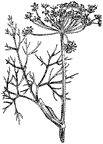 Growth category
Growth category
Annual- Light
Bright - Soil
Rich, well drained - Height
24 to 36 inches - Propagation
Seed in spring - Hardiness
Hardy annual - Comments
Do not plant with fennel - Description
An annual with dark green stems and feathery bluish-green leaves. Flowers are yellow in flat umbels. Chopped leaves and seeds have many uses.
Fennel, sweet; Foeniculum dulce
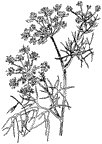 Growth category
Growth category
Perennial- Light
Bright - Soil
Well drained - Height
48 to 72 inches - Propagation
Seed in spring, division - Hardiness
Hardy - Comments
Less vigor in clay soils - Description
There are several species, but sweet fennel is considered most desirable. Leaves are bright green and delicate below umbels of yellow flowers. It has a faint anise fragrance. Traditionally used with fish, but now has many uses.
Horehound; Marrubium vulgare
- Growth category
Perennial - Light
Bright - Soil
Dry - Height
24 inches - Propagation
Seed in spring, division, cuttings - Hardiness
Hardy - Comments
Alkaline soils - Description
A coarse perennial covered with whitish hairs. Leaves are crinkled. Leaves and small stems should be cut before flowering begins. Most popular use is to flavor candy.
Hyssop; Hyssopus officinalis
- Growth category
Perennial - Light
Bright - Soil
Dry - Height
24 inches - Propagation
Seed in spring, division, cuttings - Hardiness
Hardy - Comments
Cut back in spring - Description
A hardy perennial with small, pointed leaves, spikes of blue flowers and woody stems. Harvest only youngest leaves, which may be added to salads. Flavor is slightly bitter and minty. Used to flavor liqueurs and sometimes as a condiment.
Lavender; Lavandula angustifolia
- Growth category
Perennial - Light
Bright - Soil
Dry - Height
18 to 24 inches - Propagation
Seed in fall, cuttings - Hardiness
Hardy - Comments
Evergreen, may winter-kill - Description
Several different species may be grown, but English lavender is considered the finest. Plants are bushy with narrow grayish-green leaves. Flowers are bluish purple spikes. All parts of the plant contain the scent, but it is strongest in the flowers. Much used in potpourri and sachets. Also used for tea.
Lemon balm; Melissa officinalis
- Growth category
Perennial - Light
Bright, light shade - Soil
Moist - Height
18 to 24 inches - Propagation
Seed in spring, division, cuttings - Hardiness
Hardy - Comments
Can be grown indoors, weedy - Description
Perennial plant with light green, heart-shaped leaves that are deeply veined. Yellowish-white flowers appear throughout the summer. May be harvested several times during the season, but first harvest is considered best. Many uses, but frequently added to jams, jellies and fruit salads.
Lemon verbena; Aloysia triphylla
- Growth category
Woody perennial - Light
Bright, light shade - Soil
Well drained - Height
48+ inches - Propagation
Seed in spring, cuttings - Hardiness
Half hardy - Comments
Rarely survives winter, good indoors - Description
Nonhardy, woody shrub for pots and indoor use. Long, pointed, dark green leaves come from each stem node in groups of three leaves. Lemon verbena adds a lemony taste to teas, cold drinks and jellies.
Lovage; Levisticum officinale
 Growth category
Growth category
Perennial- Light
Bright, light shade - Soil
Rich, moist - Height
36 to 60 inches - Propagation
Seed in fall - Hardiness
Hardy - Comments
Self-seeds - Description
A tall perennial plant with shiny, dark green leaves. Has hollow stems that terminate in clusters of yellow flowers. Leaves, young stems and roots are eaten. It gives a slightly spicy taste to many dishes or soups.
Marjoram, sweet; Origanum majorana
- Growth category
Perennial - Light
Bright, light shade - Soil
Rich, well drained - Height
8 to 12 inches - Propagation
Seed in spring, cuttings - Hardiness
Half hardy - Comments
Good in pots, sow seeds as annual - Description
There are three major species, one of which is sometimes called oregano. Sweet marjoram is used as an annual plant often with thyme. It is sweet and spicy. Plants are low growing with small, gray-green leaves on tough, woody stems. Flowerheads have small, pale mauve to white flowers. The delicate flavor is most used for beef, game or poultry.
Myrtle; Myrtus communis
- Growth category
Woody perennial - Light
Bright - Soil
Well drained - Height
60+ inches - Propagation
Cuttings - Hardiness
Tender - Comments
Evergreen, for large containers - Description
The true myrtle is a nonhardy evergreen shrub with small evergreen leaves and small, creamy-white flowers that produce blue-black berries. Use as a pot or tub plant. Will take shearing well. Leaves used in potpourri and herb sachets.
Oregano; Origanum vulgare
 Growth category
Growth category
Perennial- Light
Bright, light shade - Soil
Well drained - Height
18 to 24 inches - Propagation
Seed in spring, division, cuttings - Hardiness
Hardy - Comments
Cut back in late fall - Description
A sprawling plant with leaves much coarser than sweet marjoram. Although called oregano, there is some disagreement as to the best source of the oregano flavor. Among other plants with an oregano flavor, Spanish thyme, Thymus nummularius, is an alternative.
Parsley; Petroselinum crispum
- Growth category
Biennial - Light
Bright, light shade - Soil
Rich, moist - Height
6 to 10 inches - Propagation
Seed in spring - Hardiness
Half hardy - Comments
Often self-seeds - Description
A biennial plant with often curly, dark green foliage. Seeds are slow to germinate. Well known and the most popular of all herbs.
Peppermint; Mentha piperita
- Growth category
Perennial - Light
Bright, light shade - Soil
Moist - Height
12 to 24 inches - Propagation
Division, cuttings - Hardiness
Hardy - Comments
Spreads easily, good indoors - Description
A spreading plant with numerous upright shoots that may reach a height of 2 feet. Dark green leaves are produced from reddish stems. Grows best in moist soils. Best cut just as flowering begins. Mints can be invasive.
Rosemary; Rosmarinus officinalis
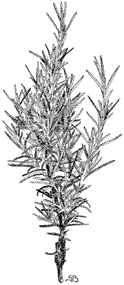 Growth category
Growth category
Woody perennial- Light
Bright - Soil
Dry, well drained - Height
36 inches - Propagation
Cuttings - Hardiness
Tender - Comments
Alkaline soils, good in pots - Description
May grow outdoors for summer, but not winter-hardy outdoors. Needs sunny location and well-drained soil. Can be pruned severely if necessary to keep in proportion with pot size. Popular for veal, lamb, shellfish and other meats.
Sage; Salvia officinalis
 Growth category
Growth category
Woody perennial- Light
Bright - Soil
Dry, well drained - Height
24 to 36 inches - Propagation
Seed in spring, cuttings - Hardiness
Hardy - Comments
Replace plants every 5 years - Description
A woody plant with oblong leaves that have a wooly, gray-green covering that is lighter on the bottom. May grow 2 feet high but tends to sprawl. Several forms are available, including purple-leaved, variegated-leaved and dwarf growing. Needs a sunny location and well-drained soil. Used with meats and dressings.
Sage, pineapple; Salvia elegans
- Growth category
Perennial - Light
Bright - Soil
Well drained - Height
24 to 48 inches - Propagation
Seed in spring, cuttings - Hardiness
Half hardy - Comments
Good indoors - Description
Not reliably winter-hardy and should be overwintered in pots. Has rough, pointed leaves and attractive cardinal red flowers. Used to give a pineapple scent to potpourris or to add flavor to drinks such as iced tea.
Savory, summer; Satureja hortensis
- Growth category
Annual - Light
Bright - Soil
Rich - Height
18 inches - Propagation
Seed in spring - Hardiness
Half hardy - Comments
Trim back during season - Description
Produces small, bronze-green leaves and small white or lavender flowers. The small leaves are less conspicuous than the stems. Cut when in bud and hang to dry. Used as a condiment for meats and vegetables.
Savory, winter; Satureja montana
- Growth category
Woody perennial - Light
Bright - Soil
Well drained - Height
24 inches - Propagation
Seed in fall, division, cuttings - Hardiness
Hardy - Comments
Alkaline soil - Description
This woody plant has shiny, pointed, dark green leaves and small white or lavender flowers. Needs a well-drained, sandy soil. Dead branches should be trimmed out. May be picked and dried at any time.
Spearmint; Mentha spicata
 Growth category
Growth category
Perennial- Light
Bright, light shade - Soil
Moist - Height
18 inches - Propagation
Division, cuttings - Hardiness
Hardy - Comments
Spreads easily, good indoors - Description
Has slightly crinkled leaves lighter green than peppermint. Needs moist soil, but very hardy. Leaves and stems may be picked anytime. For drying, pick stems as flowering begins. Leaves used in cold drinks or to make mint sauce.
Tarragon; Artemisia dracunculus
- Growth category
Perennial - Light
Bright - Soil
Rich, dry - Height
24 inches - Propagation
Division, cuttings - Hardiness
Hardy - Comments
Needs winter protection - Description
Has somewhat twisted, narrow, dark green leaves. Grows best in partial shade. Fairly hardy, but needs winter protection to ensure survival in colder climates. Leaves and stems are used fresh to flavor vinegar. Flavor is lost during drying.
Thyme; Thymus vulgaris
- Growth category
Woody perennial - Light
Bright - Soil
Dry - Height
6 to 10 inches - Propagation
Seed in spring. cuttings, division - Hardiness
Hardy - Comments
Evergreen, grows indoors - Description
Stems are low-growing, wiry and woody. Leaves are small and usually gray-green. Needs bright light and well-drained soil. Plants are not long-lived and may need replacement every few years. Other forms of thyme are also useful and attractive. Mother-of-thyme is a prostrate-growing species only a few inches in height. Lemon thyme is also popular. All thyme species may be used for seasoning food. Shoots should be harvested while in flower.
Woodruff, sweet; Asperula odorata
 Growth category
Growth category
Perennial- Light
Shade, light shade - Soil
Moist - Height
6 to 8 inches - Propagation
Division, cuttings - Hardiness
Hardy - Comments
Good groundcover - Description
A low-growing perennial with shiny leaves in whorls around each stem. Should be grown in shady, woodland sites for best growth. Remove leaves just as the herb comes into flower or during flowering. Has been used for potpourri or strewn in storage cupboards and among linen. Used for the May cup or May wine. Best flavor occurs after leaves have wilted slightly.

Audio clip 1
This example of an old-fashioned formal knot garden shows how the spaces in the design can separate different types of herbs.
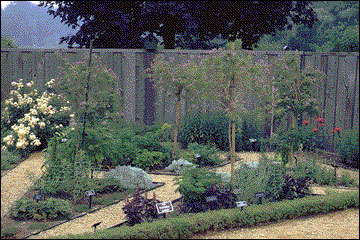
Audio clip 2
Walks arranged as the spokes of a wheel separate different types of herbs in this garden.
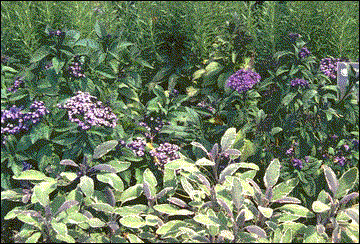
Audio clip 3
Herbs can be combined and blended with other plants. Here, variegated purple sage is blended with heliotrope.
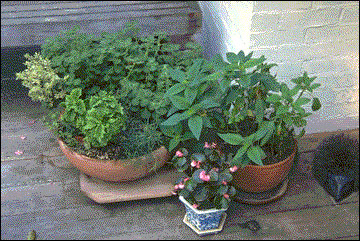
Audio clip 4
Herbs are suitable for container growing. In the heat of summer, regular watering and fertilization are necessary.